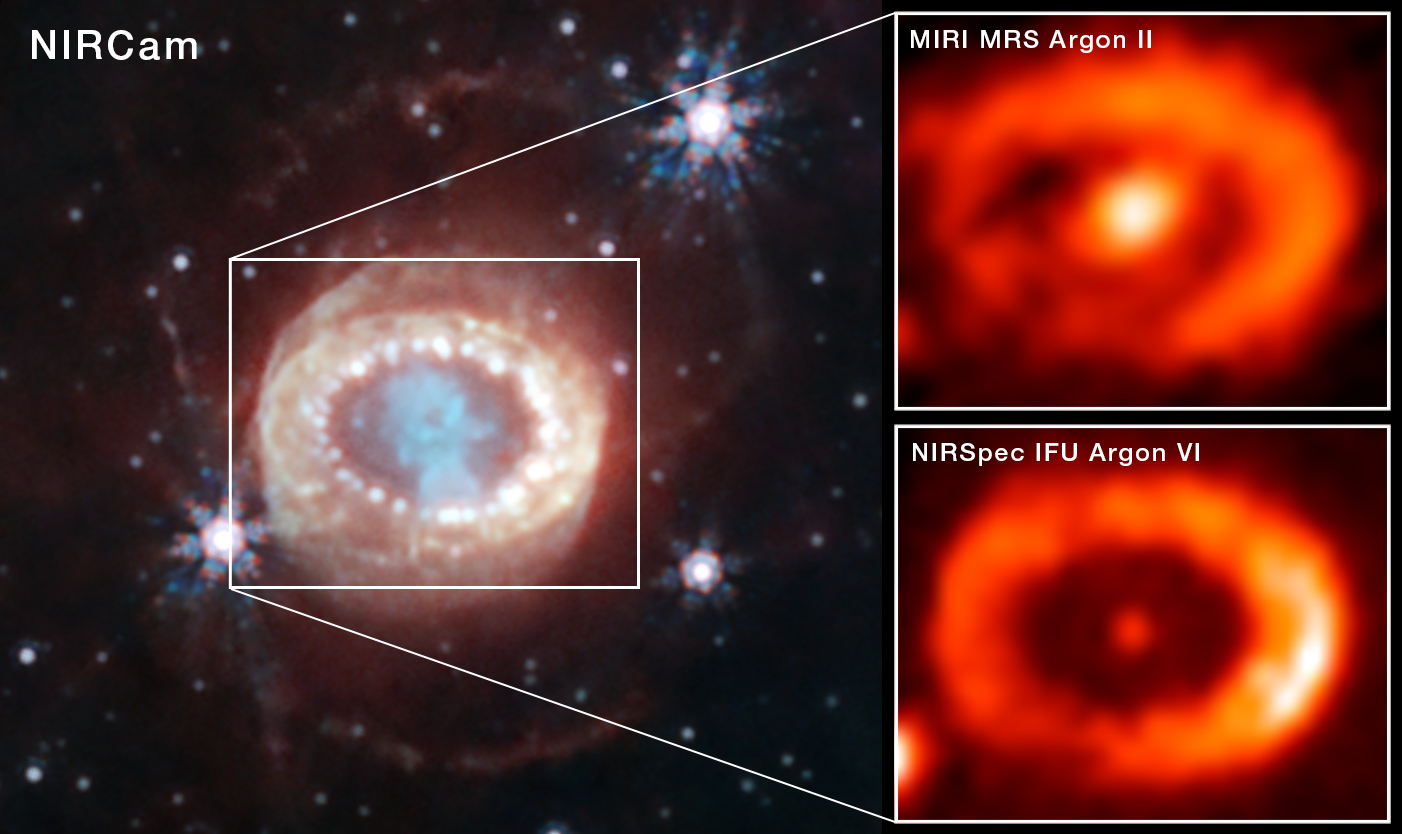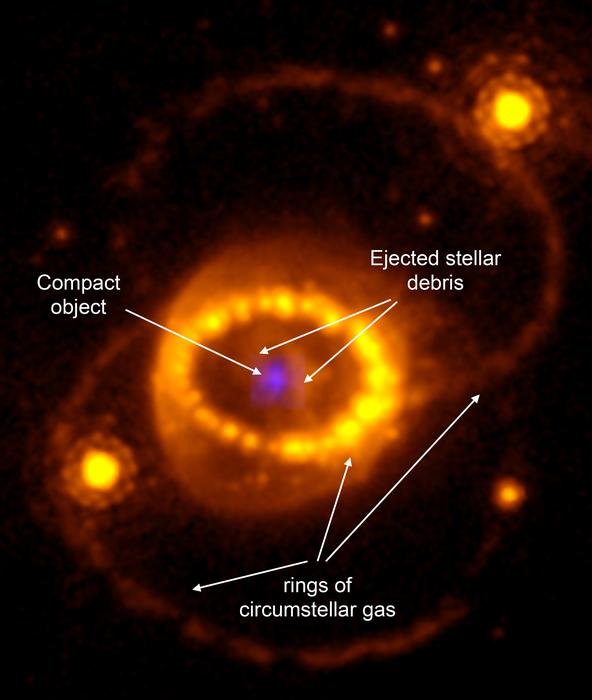
Using the James Webb Space Telescope (JWST), astronomers have ended a nearly decade-long game of celestial hide-and-seek after they discovered a neutron star in the wreckage of a stellar explosion.
Supernova 1987A represents the remains of an exploded star that once had a mass around 8 to 10 times that of the sun. It is located around 170,000 light-years away in the Large Magellanic Cloud, a dwarf galaxy neighbor of the Milky Way. Supernova 1987A was first spotted by astronomers 37 years ago in 1987, hence the numerical aspect of its name. As it exploded, Supernova 1987A first showered Earth with ghostly particles called neutrinos and then became visible in bright light. This made it the nearest and brightest supernova seen in the night sky over Earth for around 400 years.
Supernova explosions such as this are responsible for seeding the cosmos with elements like carbon, oxygen, silicon and iron. These elements ultimately become the building blocks of the next generation of stars and planets, and can even form molecules that may one day become integral to life as we know it. These explosions also birth compact stellar remnants either in the form of neutron stars or black holes; for 37 years, astronomers haven't known which of these may lurk at the heart of Supernova 1987A.
"For a long time, we've been searching for evidence for a neutron star in the gas and dust of Supernova 1987A," Mike Barlow, an emeritus professor of physics and astronomy and part of the team behind this discovery, told Space.com. "Finally, we have the evidence that we've been seeking."
Related: James Webb Space Telescope finds neutron star mergers forge gold in the cosmos: 'It was thrilling'
How does a neutron star hide for 4 decades?
Neutron stars are born when massive stars exhaust their fuel supplies needed for nuclear fusion happening at their cores. This cuts off the outward energy flowing from these stars' cores that protects them from collapsing under their own gravity.
As a stellar core collapses, tremendous supernova explosions rip through the star's outer layers, blasting them away. This leaves behind a "dead" star as wide as the average city here on Earth, but with a mass around one or two times that of the sun; the star ends up composed of a fluid of neutron particles, which is the densest known matter in the universe.
Neutron stars are supported against complete collapse, however, by quantum effects occurring between neutrons in their interiors. These effects prevent the neutrons from cramming together. This so-called "neutron degeneracy pressure" can be overcome if a stellar core has enough mass — or if a neutron star, after its creation, piles on more mass. This would result in the birth of a black hole (if the mass minimum isn't reached, though, it won't happen.)
Scientists have been fairly sure that the object in Supernova 1987A is a neutron star, but they couldn't rule out the possibility that this newly deceased star, at least as we see it 170,000 or so years ago, hadn't gathered the mass to transform itself into a black hole.
"One other possibility was that the infalling matter could have been accreted onto the neutron star and caused it to collapse into a black hole. So, a black hole was a possible alternative scenario," Barlow said. "The spectrum that infalling material produces is not the right type of spectrum to explain the emission that we see, however."

You're getting warmer...
The newly identified neutron star had avoided detection for 37 years due to the fact that, as a newborn, it was still surrounded by a thick shroud of gas and dust launched during the supernova blast that signaled the death throes of its progenitor star.
"Detection has been hindered by the fact that the supernova condensed about half a solar mass of dust in the ensuing years after the explosion," Barlow said. "This dust acted as a screen-obscuring radion from the center of Supernova 1987A."
The dust is far less effective at blocking infrared light than it is at blocking visible light. So, to see through this death shroud and into the heart of Supernova 1987A, Barlow and colleagues turned to the highly sensitive infrared eye of the JWST, particularly the telescope's Mid-Infrared Instrument and Near-Infrared Spectrograph.
The smoking gun evidence for this hidden neutron star had to do with emissions from the elements argon and sulfur coming from the center of Supernova 1987A. These elements are ionized, meaning they have had electrons stripped from their atoms. Barlow said that this ionization could have only occurred due to radiation emitted by a neutron star.
The emissions enabled the team to put a limit on the brightness or luminosity of the once-hidden neutron star. They determined it to be around a tenth of the brightness of the sun.
The team may have determined that a neutron star was birthed by Supernova 1987A, but not all the mysteries of this neutron star are solved yet.
That's because the ionization of argon and sulfur that served as their smoking gun could have been caused by a neutron star in one of two ways. Winds of charged particles dragged along and accelerated to near light speed by a rapidly rotating neutron star could have interacted with surrounding supernova material, causing the ionization. Or, ultraviolet and X-ray light emitted by the million-degree surface of the hot neutron star could have stripped electrons away from atoms at the heart of this stellar wreckage.
If the former scenario is the right one, then the neutron star at the heart of Supernova 1987A is actually a pulsar surrounded by a pulsar wind nebula. Pulsars are pretty much spinning neutron stars. If the latter scenario is the right recipe for these emissions, however, this close supernova birthed a "bare" or "naked" neutron star, the surface of which would be exposed directly to space.
Barlow suggested that researchers may be able to distinguish between a naked neutron star and one clothed by a pulsar-wind nebula by making further infrared observations of the heart of Supernova 1987A with the JWST's NIRSpec instrument.
"We have a program which is gathering data now, which will be getting data with 3 or 4 times the resolution in the near-infrared," he concluded. "So by obtaining these new data, we may be able to distinguish the 2 models that have been proposed to explain the emission powered by a neutron star."
The team's research was published on Thursday (Feb. 22) in the journal Science.






